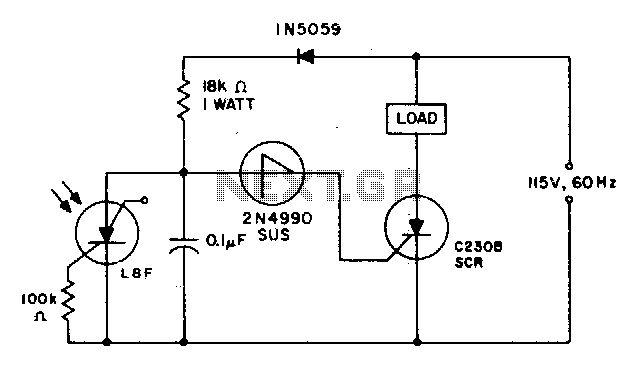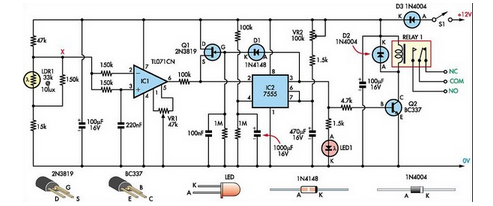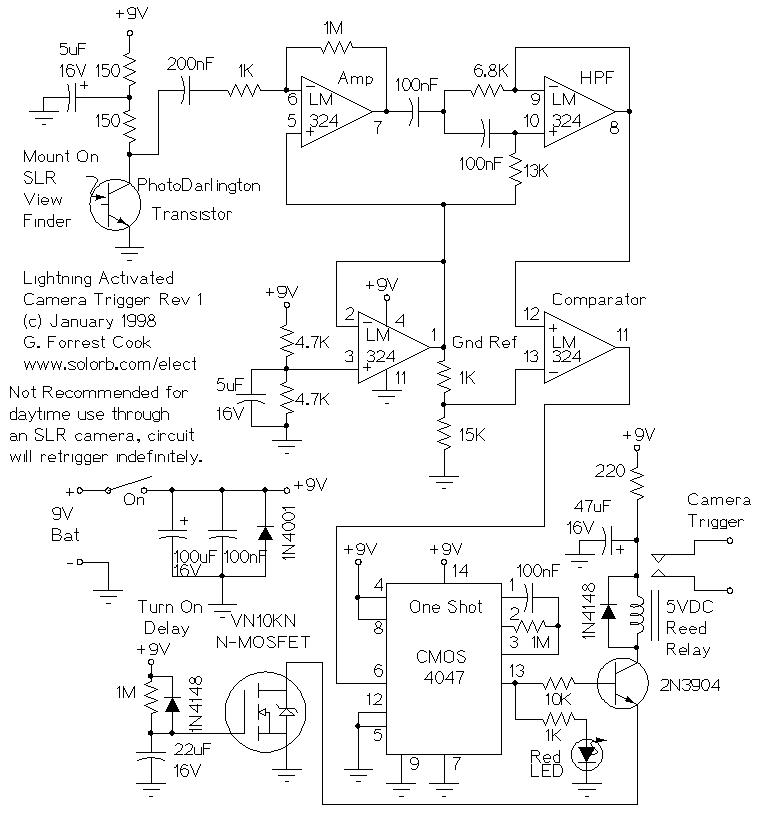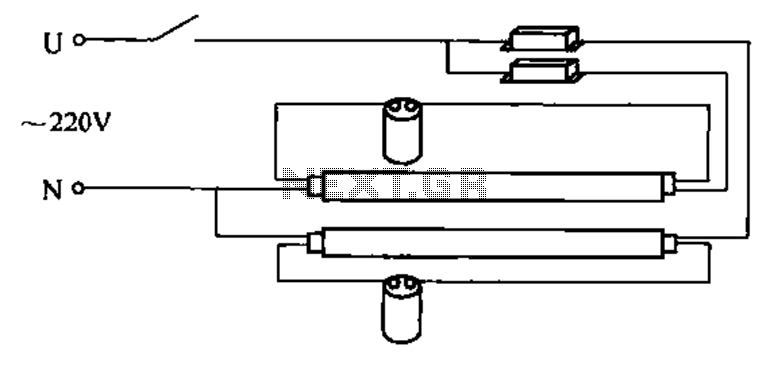
Infrared Light Controled Switch

This circuit is a simple remote-controlled relay capable of switching lamps or other devices. D1 can be a phototransistor, LDR, or an infrared transistor. The circuit is controlled using an IR remote, similar to a TV remote control, when the IR transistor is utilized. The circuit sensitivity can be adjusted with RV2.
The remote-controlled relay circuit operates by using a light-sensitive component as the primary sensor. Depending on the choice of D1, the circuit can be configured to respond to different types of light signals. For instance, if a phototransistor is used, it will react to ambient light changes, while an LDR (Light Dependent Resistor) will respond to varying light levels. An infrared transistor, on the other hand, will specifically respond to infrared signals emitted by an IR remote control.
The main components of the circuit include a relay, which is responsible for switching the connected load (such as lamps), and the light-sensitive device (D1). When the appropriate light signal is detected, the relay is activated, allowing current to flow to the load. The relay's operation is crucial for isolating the control circuit from the high-power load, ensuring safe operation.
The adjustment of circuit sensitivity is facilitated by the variable resistor RV2. This component allows for fine-tuning the threshold at which the relay activates in response to the light input. By rotating RV2, the user can increase or decrease the sensitivity, allowing the circuit to function optimally in various lighting conditions or distances from the remote control.
In summary, this remote-controlled relay circuit is a versatile solution for controlling electrical devices wirelessly. Its design is straightforward, making it suitable for hobbyists and professionals alike, and it can be adapted for various applications by selecting the appropriate light sensor and adjusting the sensitivity.This circuit is simple remote controlled relay. It is able to switch lamps or other devices. D1 can be a phototransistor or LDR or an infrared transistor. circuit is controlled with an IR remote like a TV remote control (when IR transistor is used) You can change circiut sensitivity with RV2. 🔗 External reference
The remote-controlled relay circuit operates by using a light-sensitive component as the primary sensor. Depending on the choice of D1, the circuit can be configured to respond to different types of light signals. For instance, if a phototransistor is used, it will react to ambient light changes, while an LDR (Light Dependent Resistor) will respond to varying light levels. An infrared transistor, on the other hand, will specifically respond to infrared signals emitted by an IR remote control.
The main components of the circuit include a relay, which is responsible for switching the connected load (such as lamps), and the light-sensitive device (D1). When the appropriate light signal is detected, the relay is activated, allowing current to flow to the load. The relay's operation is crucial for isolating the control circuit from the high-power load, ensuring safe operation.
The adjustment of circuit sensitivity is facilitated by the variable resistor RV2. This component allows for fine-tuning the threshold at which the relay activates in response to the light input. By rotating RV2, the user can increase or decrease the sensitivity, allowing the circuit to function optimally in various lighting conditions or distances from the remote control.
In summary, this remote-controlled relay circuit is a versatile solution for controlling electrical devices wirelessly. Its design is straightforward, making it suitable for hobbyists and professionals alike, and it can be adapted for various applications by selecting the appropriate light sensor and adjusting the sensitivity.This circuit is simple remote controlled relay. It is able to switch lamps or other devices. D1 can be a phototransistor or LDR or an infrared transistor. circuit is controlled with an IR remote like a TV remote control (when IR transistor is used) You can change circiut sensitivity with RV2. 🔗 External reference





